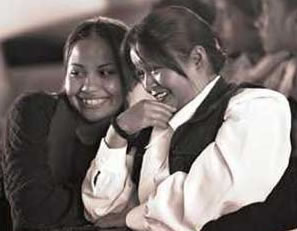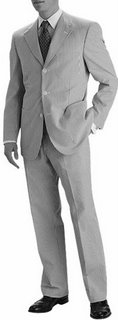The NonVerbal Thesaurus
NonVerbal:
Not spoken > Body Language.
Thesaurus:
~~~~~~~~~~~~~~~~
Latin thesaurus, treasury, from Greek thesauros.
~~~~~~~~~~~~~~~~
n. pl. the•sau•ri (-sôri) or the•sau•rus•es
1. A book of synonyms, often including related and contrasting words and antonyms.
2. A book of selected words or concepts, such as a specialized vocabulary of a particular field.
~~~~~~~~~~~~~~~~
The American Heritage® Dictionary of the English Language, Fourth Edition copyright ©2000 by Houghton Mifflin Company. Updated in 2009.
Dialogue is VISUAL -- Not just a bunch of words.
Watch the average conversation between two people. 90% of that conversation isn't in what's Spoken, it's in what they are DOING while they are speaking. It's in their Body Language. Body-language cues in your story alert the reader by SHOWING them what is going on in a character’s head without Telling them, and without resorting to using the most often repeated word in fiction: said.
~~~~~~~~~~~~~~~~
"I love you too." She raised her balled fist and smiled with bared teeth. “Oh yes, I truly do love you.” She thrust up her middle finger.
~~~~~~~~~~~~~~~~
How to use this List.
DON'T try to copy-paste any of this directly into your story! While the terms listed are accurate, they're also Scientific. It's up to you to swap out the scientific terms for more fitting literary phrases to suit your story.
Example:
~~~~~~~~~~~~~~
She was angry. "How dare you...?"
Body language cue:
~~~~~~~~~~~~~~
Anger:
a. Jaws tensed to a biting position; “I’m going to bite you!”
Adjusted:
~~~~~~~~~~~~~~
She clenched her jaw, grinding her teeth. "How dare you...?"
Got it?
The NONVERBAL THESAURUS
A Writer's Cheat-Sheet to BODY LANGUAGE CUES
A Writer's Cheat-Sheet to BODY LANGUAGE CUES
KEY: The gesture; the meaning behind the gesture.

ANGER
Annoyance, Resentment, Rage
a. Jaws tensed to a biting position; “I’m going to bite you!”
b. Chest expansion, squaring of shoulders, and/or hands-on-hips; “I’m bigger than you.”
c. Cut-off and head-jerk cues; “No. I don’t want that.”
d. Hand-behind-head / hand-above-head. “I may or may not strike you.”
e. Fists, palm-down beating gestures. “I will strike you!”
f. Frowning and tense-mouth expressions; “Don’t make me bite you.”
g. Growling voice tones; “Consider me a threat.”
h. Staring; “I consider you a threat.”
I. Gaze avoidance; the head is turned fully away to one side; “Run while I am not looking and I will not attack you.”

DISGUST
Revulsion, Loathing, Nausea
a. Curled upper lip, a retracted upper lip, and mouth movements. "I feel like vomiting."
b. Digestive sounds of revulsion. Guttural sounds ("ach" or "ugh"); "I AM going to vomit!"
c. Narrowed or partly closed eyes; “I don't want to see that!”
d. Lowered brows of the frown face. "I don't want to smell that!"
e. Backward head-jerks and side-to-side head-shakes. “I don't want to taste that!”
f. Visible protrusions of the tongue. “I can see that it tastes bad.”

FEAR
Anxiety, Apprehension, Dread
a. Angling body away; “Don’t touch me.”
b. Release of underarm scent; “Go away! I am unappealing! I stink!”
c. Increase in breathing rate. "I'm going to run away!"
d. Trembling and/or chattering teeth. "I want to run away!"
e. Crouching. “Don’t hurt me!”
f. Crying. “I’m hurt enough!”
g. Displacement gestures; “How did THIS happen?”
h. Fast eye-blink rate. “I don’t believe what I'm seeing!”
i. Fear grin. “I’m friendly! Honest!”
j. Widely opened flashbulb eyes. “I can’t believe this!”
k. Unconscious escape motions designed to remove a body part, or parts, from danger (e.g., flexing the neck to lower and protect the head). "Don't hit me!"
l. Freeze reactions; “Am I in danger?”
m. Hair-bristling; “I feel danger!”
n. Accelerated heart rate. "I'm getting ready to run away!"
o. Tightened shoulder muscle tension; “It's going to hit me!”
p. Screaming; “Don’t touch me!”
q. Squirm cues; “Let go of me.”
r. Staring eyes with wide-dilated pupils; “How much danger am I in?”
s. Sweaty palms. "I don't wanna touch that!"
t. Tense-mouth. “Don’t make me bite you.”
u. Throat-clearing. “I want to vomit.”
v. Audibly tense tone-of-voice, either low and close to a growl, "I'm warning you..." or high to present a non-threatening sound. "I'm not a threat!"
w. Yawning. “I have no fangs, see? I’m not a predator!”

HAPPINESS
Contentment, Well-being, Joy
a. Laugh or smile
b. Tears; “I am overwhelmed.”
Unlike most other facial signs of emotion, the smile is subject to learning and conscious control. In the U.S., Japan, and many other societies, children are taught to smile on purpose, e.g., in a courteous greeting, whether or not they actually feel happy. A true (i.e., involuntary) smile, crinkles the skin around the outside corners of our eyes, forming "crow's feet" or smiling eyes.

SADNESS
Sorrow, Unhappiness, Depression, Gloom
a. Bowing postures; “I’m terribly sorry.”
b. Cry face and lip-pout; “Please don't hurt me anymore.”
c. Gazing-down; “I am not a challenge.”
d. Slumped flexed-forward posture of the shoulders; “I give up.”
e. Audible sigh; “I give up.”
f. Compressed lips; “No, I don’t want that.”
The facial features constrict as if to seal-off contact with the outside world. In acute sadness, muscles of the throat constrict and repeated swallowing occurs, the eyes close tightly, and then tears.

UNCERTAINTY
Indecision, Misgiving, Doubt
~~~~~~~~~~~~~~~~
a. Involuntary sideward eye movements; “Where is the danger coming from?”
b. Self-touching gestures; “Am I still in one piece?”
c. Frown; “I don’t want that…”
d. Hand-behind-head; “I don’t like it.”
e. Side-to-side head-shakes “No.”
f. Sideward head-tilts; “I don’t want that…”
g. Lip-pout, lip-purse, and tense-mouth expressions “That looks like it tastes bad.”
h. Palm-up gestures; “I surrender.”
i. Shoulder-shrug; “Don’t touch me.”
Men will rub their chins with their hand, tug at the lobes of their ears, or rub their forehead or cheeks or back of the neck, in reaction to the increased tension. Male college students express uneasiness by changing their sitting posture to a more direct body orientation. “I’m going to defend myself.”
Women will put a finger on their lower front teeth with the mouth slightly open or pose a finger under the chin. “See? I have no fangs, I am not a predator.” Female college students show uneasiness by sitting still and arm-crossing. “Don't touch me.”

SUBMISSION
Acknowledgment, Compliance, Surrender
~~~~~~~~~~~~~~~~
a. Turning away “No thank you.”
b. body-bend, body-shift, and bowing “Please don’t…”
c. displacement cues “How did THIS happen?”
d. facial flushing; Blood rushing to enhance the senses: hearing, sight, taste, smell. ; Blood rushing to enhance the senses: hearing, sight, taste, smell.
e. freeze reactions “Am I in danger?”
f. gaze-down; “I am not a threat.”
g. give-way; “I will not challenge you.”
h. head-tilt-side; “Don’t…”
i. Mimic of superior’s body movements “I will not challenge you.”
j. laughing; “I will not challenge you.”
k. palms-up; “I surrender.”
l. exaggerated personal distance; “Don’t touch me.”
m. pigeon toes; “I can't chase you, I am not a threat.”
n. shoulder-shrugging; “Don’t touch me.”
o. shyness; “Don’t notice me.”
p. difficulty gazing directly at, or cross lines of sight with, a dominant individual. "I don't want to challenge you."
q. higher vocal pitch "I'm weak, and helpless."
r. yawning; “No fangs, see? I am not a threat.”
(Note the considerable overlap between expressions of submission and fear.)

DOMINANCE
Influence, Power, Control
~~~~~~~~~~~~~~~~
a. Eyebrow raise; “Are you challenging me?”
b. Hands-on-hips posture; “I’m ready for battle.”
c. Head-tilt-back; “I dare you to bite me.”
d. Palm-down gesture; “Do I need to strike you?”
e. Swagger walk; “I’m stronger than you.”
f. Table-slap; “I will strike you!”
g. Lower tone of voice, close to a growl. "Don't make me bite you."
h. Wedge-shaped Chest expansion, squaring of shoulders; “I’m bigger than you.”
i. Direct stare; “I consider you a threat.”
j. Looming with chin down; “I will bite you.”
Aggressive behaviors include the head brought forward toward another person, chin out and pushed forward, wrinkled skin on the bridge of the nose, and a sharp movement of the head towards the other person, as though in preparation to bite.
The Business Suit
Built-in Aggression

Built-in Aggression

The business suit allows a powerful, influential ‘wedge-like’ silhouette for business and public affairs.
Exaggerated Chest expansion, squaring of shoulders Strength cues are tailored into every Brooks Brothers® suit. The coat's squared shoulders exaggerate the size and strength of the upright torso. Flaring upward and outward, lapels enhance the illusion of primate pectoral strength. Dropped to fingertip level, the jacket's hemline visually enlarges the upper body to gorilla-like proportions. Pads and epaulets cover inadvertent shrugs and slips of the shoulder blades, to mask feelings of submission or uncertainty in the boardroom--or on the battlefield.

LOVE
Affection, Devotion, Attachment
~~~~~~~~~~~~~~~~
a. Physical contact, including hugs and kisses. "I like you."
b. Increased breathing rate; “I want to smell you.”
c. Courtship behavior; “I want to make love to you.”
d. Direct gaze with wide pupils; “I find you pleasing to look at.”
e. Facial flushing; blood rushing to enhance the senses: hearing, sight, taste, smell.
f. Head-tilt-side; “Do I have your attention?”
g. Increased heart rate; to enhance the senses: hearing, sight, taste, smell.
h. Mimic of behavior and/or appearance; “We make a set, we belong together.”
i. Softened tone of voice; “If you want to hear what I say, come closer.”
j. Closing personal distance; "I want to touch you."
Summary of common Facial Cues.
1. Nose:
~~~~~~~~~~~~~~~~
a) nostril flare; "Oh that scent!" (arousal, rivalry)
b) nose wrinkle; (disgust)
2. Lips:
~~~~~~~~~~~~~~~~
a) grin (happiness, friendship, contentment)
b) grimace (fear)
c) lip-compression (anger, emotion, frustration)
d) canine snarl (disgust)
e) lip-pout (sadness, submission, uncertainty)
f) lip-purse (disagree)
g) sneer (contempt)
3. Brows:
~~~~~~~~~~~~~~~~
a) frown (anger, sadness, concentration)
b) brow-raise (intensity)
4. Tongue:
~~~~~~~~~~~~~~~~
tongue-show (dislike, disagree)
5. Eyelids:
~~~~~~~~~~~~~~~~
a) flashbulb eyes (surprise)
b) widened (excitement, surprise)
c) narrowed (threat, disagreement)
d) fast-blink (arousal)
e) normal-blink (relaxed)
6. Eyes:
~~~~~~~~~~~~~~~~
a) big pupils (arousal, fight-or-flight)
b) small pupils (rest-and-digest)
c) direct-gaze (affiliate, threaten)
d) gaze cut-off (dislike, disagree)
e) gaze-down (submission, deception)
f) CLEMS* (thought processing) This is an acronym for "Conjugate Lateral Eye Movement." When the eyes move sideward (to the right or left) in response to a question. Rightward movement is associated with symbolic thinking, or Memory, (what we KNOW,) while Leftward Movement is associated with visual thinking, or Creativity, (what we INVENT).
In conclusion...
-- Don't just SAY it. SHOW IT!
~~~~~~~~~~~~~~~~
Skip the dialogue "he said / she said" tags altogether by using Body-language cues and ACTIONS to SHOW what the characters mean when they say: "I love you."
~~~~~~~~~~~~~~~~
“I love you too.” She rolled her eyes and sighed dramatically. “Oh yes, I truly do love you.”
“I love you too.” She dropped her chin and pouted. “Oh yes, I truly do love you.”
“I love you too.” She glared straight at him. “Oh yes, I truly do love you.”
“I love you too.” She turned away and wiped the tear from her cheek. “Oh yes, I truly do love you.”
"I love you too." She raised her balled fist and smiled with bared teeth. “Oh yes, I truly do love you.” She thrust up her middle finger.
~~~~~~~~~~~~~~~~
Enjoy!
Reference:
~~~~~~~~~~~~~~~~
The Center for Nonverbal Studies (CNS):
DISCLAIMER: As with all advice, take what you can use and throw out the rest. As a multi-published author, I have been taught some fairly rigid rules on what is publishable and what is not. If my rather straight-laced (and occasionally snotty,) advice does not suit your creative style, by all means, IGNORE IT.




